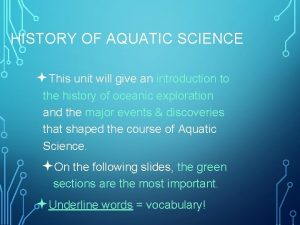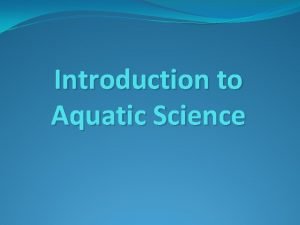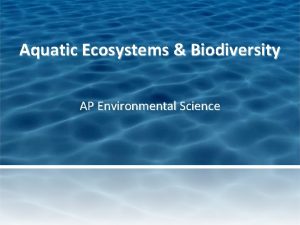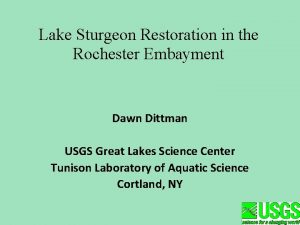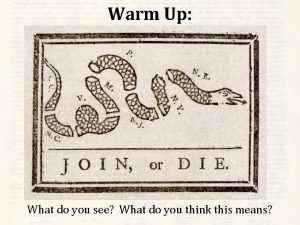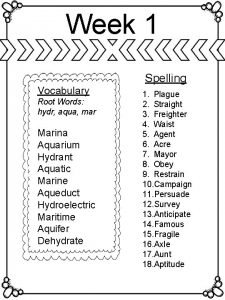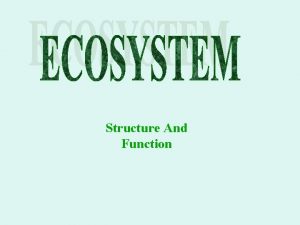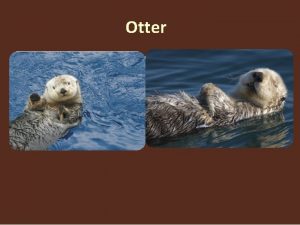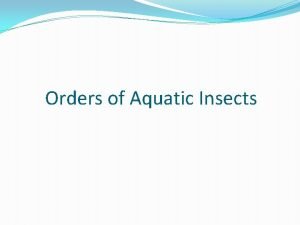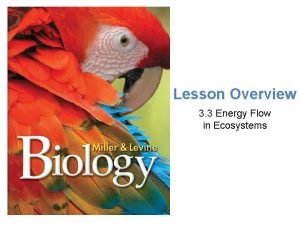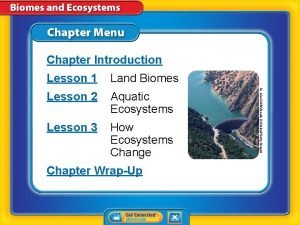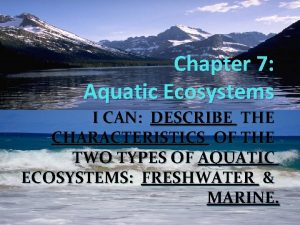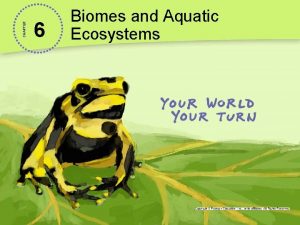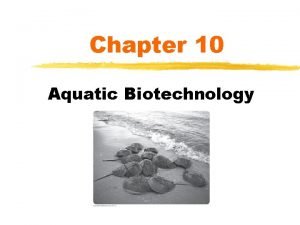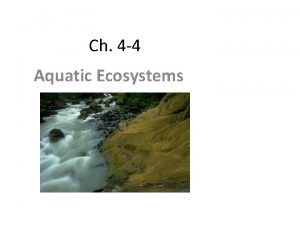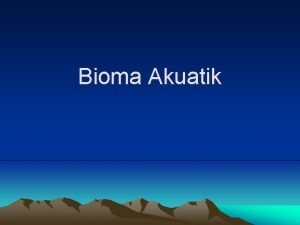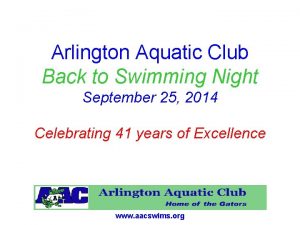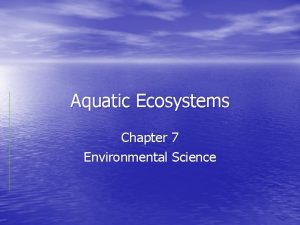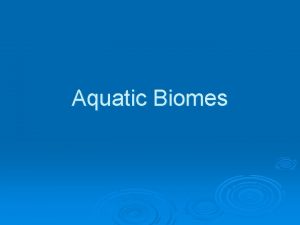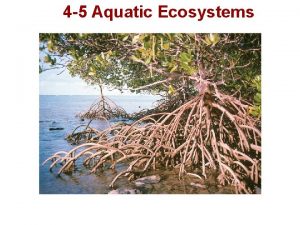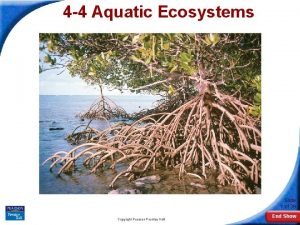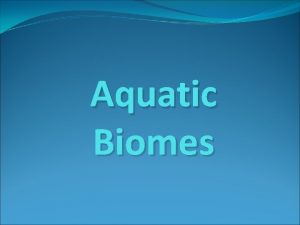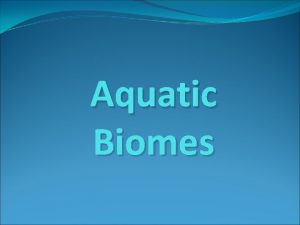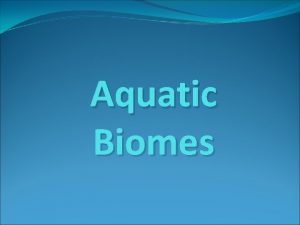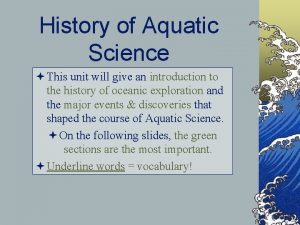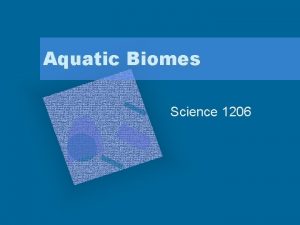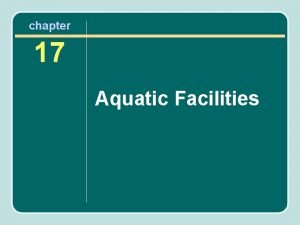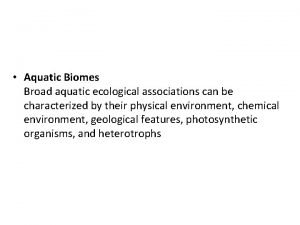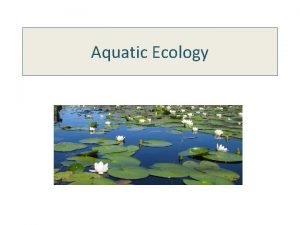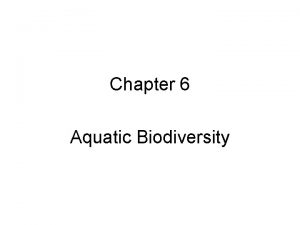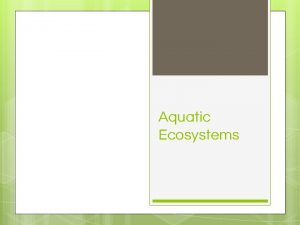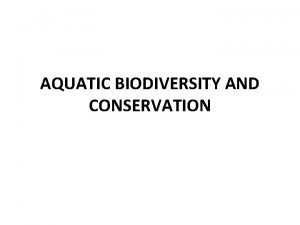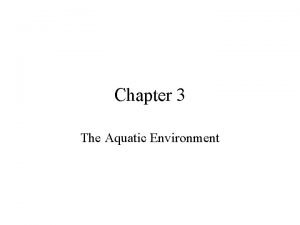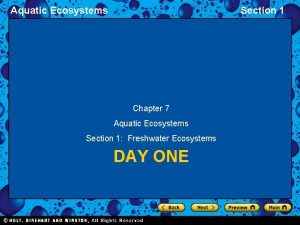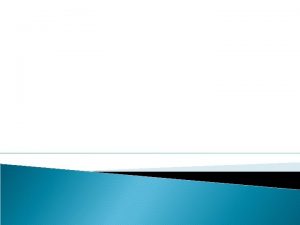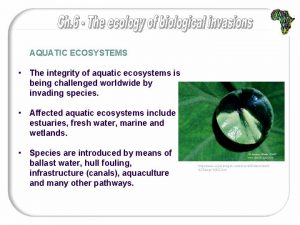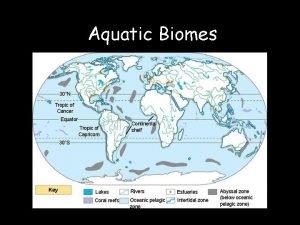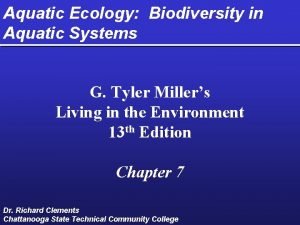HISTORY OF AQUATIC SCIENCE This unit will give

































- Slides: 33

HISTORY OF AQUATIC SCIENCE ªThis unit will give an introduction to the history of oceanic exploration and the major events & discoveries that shaped the course of Aquatic Science. ªOn the following slides, the green sections are the most important. ªUnderline words = vocabulary!

AQUATIC SCIENCE ªWhat is Aquatic Science? ªThe study of all water environments, and the plants, animals, and organisms that live in them. http: //habitatnews. nus. edu. sg/news/pulauhantu/images/LIT 0007%20 blog. jpg

BACKGROUND • About ¾ of our Earth is • • water; without water, life on Earth as we know it would not exist. The ocean is one of our last frontiers – the last places to discover. Since the beginning of time human kind has required water for survival. http: //watserv 1. uwaterloo. ca/~saibaba/Boy%20 Drinking%20 Water. jpg

THE OCEAN • Through the study of the world’s oceans, we: • Enjoy recreation • Explore aquatic animals & plants • Find food • Get our weather systems • Learn the history of the planet • Mine for minerals, oil & building materials • Trade between countries • Transport goods and people

AREAS OF STUDY IN AQUATIC SCIENCE • Physical: currents, tides, waves, pressure, • • • temperature, depth, density, as relating to weather phenomenon Geological: history of the Earth, seafloor features, sediments, changes over time Chemical: evolution and composition of seawater, its influences on animal and plant life, and impact of water pollution on the environment Biological: plants, animals and their ecosystems (life cycles, food chains, and environments)

OCEANOGRAP HY ªWhat is oceanography? ªA multiscience field encompassing geology, geophysics, chemistry, physics, meteorology, and biology as they pertain to marine ecosystems. http: //library. humboldt. edu/~rls/kelp. jpg

MARINE BIOLOGY • Marine Biology – the study of marine organisms, their behaviors, and interactions with the environment.

AQUACULTURE • Aquaculture – the management of fisheries and hatcheries, where fish eggs are incubated and hatched.

EGYPTIAN TECHNOLOGY ªThe Egyptians established sea trade throughout the Indian Ocean as early as 2300 B. C. ª 1938 - 1756 B. C. a canal was built, the Isthmus of Suez, to navigate ships across land. ªThe canal operated until 775 A. D. http: //search. eb. com. ezproxy. uhd. edu/eb/article-22787

THE PHOENICIAN S • Phoenicians: (from the Middle East) Sailed around Africa in 590 B. C. http: //search. eb. com. ezproxy. uhd. edu/eb/art-2116/Phoenician-colonization-in-the-Mediterranean

THE GREEKS ªHerodotus (a Greek): published an accurate map (see below) of the Mediterranean region, 450 B. C. ªGreeks: Developed trade routes throughout the Mediterranean and expanded their empire under Alexander the Great, 336 B. C. http: //www. henry-davis. com/MAPS/Ancientimages/109. JPEG

AMAZING MATH! • 200 B. C. – the Greek Eratosthenes mathematically calculated the circumference of the Earth to be 40, 000 km. • The circumference is 40, 032 km. • 2, 200 years ago his math was good enough to be off only 32 km!

http: //search. eb. com. ezproxy. uhd. edu/eb/art-12539/Alateen-rigged-ship-used-by-Arab-merchants THE ARABS ª 200 B. C Islamic and Arab Merchants: traded throughout the Mediterranean and Indian Oceans. ªThey are believed to have invented the lateen sail, the triangular sail important in early navigation.

IN THE MIDDLE AGES ª 900 A. D. The Vikings crossed the North Atlantic to colonize Iceland, Greenland, and Newfoundland using the North Star to determine latitude.

15 TH AND 16 TH CENTURIES • Chinese: Sailed to influence and impress their neighbors. • 1492 Columbus: Sailing for Spain, sailed the Atlantic and “discovered” the America’s. • 1497 Vasco da Gama: Sailing for Portugal, sailed around Africa from Portugal to India to establish trade routes. • Europeans searched for the Northwest passage through northern Canada to trade with Asia; and explored the Artic.

AROUND THE WORLD IN… ª 1519 - Portuguese explorer Ferdinand Magellan was on the 1 st European expedition to circumnavigate (travel all around) the world. ª 237 men began the voyage; only 18 returned. ªMagellan actually died http: //www. solarnavigator. net/history/explorers_history/ferdinand_mag ellan_charcoal_fur_robe. jpg before the journey was finished, but his crew returned in 1522.

BENJAMIN FRANKLIN ª 1762 - The American Ben Franklin created a chart of the Gulf Stream. ªThe Gulf Stream gives the US its warm climate, bringing warm water north from the equator. http: //oceanexplorer. noaa. gov/library/readings/hires/gulf_stream_map. jpg

HARRISON & COOK ª 1728 - Device invented by John Harrison (a carpenter) who was paid by the British government; a chronometer is a device that calculates longitude. ª 1768 - The English explorer Captain James Cook made 3 voyages to chart the Pacific Ocean. ªHe was the first to use a http: //www. captaincookwhitby. co. uk/captainjamescookportrait. jpg chronometer for navigation.

CHARLES DARWIN • In 1831 Charles Darwin took his voyage on the ship the HMS Beagle which led to his book “The Origin of Species” and theories of evolution. http: //uk. gizmodo. com/charles_darwin_l. jpg

MATTHEW MAURY • U. S. Navy’s Lt. Matthew • http: //www. 18 thmass. com/blog/media/2/20070417 Richmond%20 -%20 Matthew%20 Maury. jpg Maury, called the Father of Modern Oceanography, made charts and sailing directions and wrote the first book of oceanography in 1855. A Monument in Richmond, VA named him “Pathfinder of the Seas”.

THE CHALLENGER ªFrom 1872 to 1876, the ship HMS Challenger Expedition led by Sir Charles Wyville Thomson gathered more data in its time than all other data to date. • It was this voyage that discovered the world’s deepest ocean trench, the Marianas Trench, now sometimes called the Challenger Deep. http: //www. zamboanga. com/history/histor 8. jpg

20 TH CENTURY • 1898 – The world wars were the catalyst for US oceanographic research; invention of the 1 st gas engine & battery powered submarine bought by US government in 1900. http: //oceanexplorer. noaa. gov/explorations/05 arctic/background/plan/media/global_explor er_rov_600. jpg ªDevelopment of technology including electronic equipment, deep sea drilling programs, (1916) SONAR, use of GPS (global positioning system) and satellites.

THE METEOR • The Meteor Expedition: • mapped the ocean floor and features. 1925 -1927 - The German Meteor expedition surveys the South Atlantic with echosounding equipment http: //oceanexplorer. noaa. gov/history/quotes/tech/media/echo_600. jpg

THE TRIESTE ªOn January 23, 1960, the bathyscaph (small submarine) Trieste reached the greatest oceanic depth existing on our planet. ªDon Walsh and Jacques Picard (US navy) piloted the Trieste to the deepest part of the trench (35, 797 ft > http: //www. strange-mecha. com/ship/Bathyscaphe/trieste. jpg

ALVIN ªDesigned by Woods Hole Oceanographic Institute and built in 1962, Alvin has traveled around the world completing 4, 162 dives. http: //www. oar. noaa. gov/spotlite/archive/images/oceandumping_alvin. jpg • Alvin has mechanical arms and in 1966 helped to locate a Hbomb that was lost in the Mediterranean Sea. • In 1979, Alvin and its crew discovered black smokers on the sea floor.

THE GLOMAR CHALLENGER http: //www. pixel graphicsinc. com /images/Glomar. jpg • 1968 – The Glomar Challenger, a drilling vessel that proved seafloor spreading and changes in the earth’s climate by taking core samples from the sea floor.

VIEW FROM SPACE • 1985 – JASON, a satellite found and documented the wreck of the Titanic. http: //topexwww. jpl. nasa. gov/mission/images/OS TM-200707. jpg

THE JAPANESE • 1989 - Japan launched the Shinkai 6500 which can carry a crew up to 21, 414 ft deep into the ocean (a world record). http: //www. sstg. org/images/shinkai. jpg

21 ST CENTURY ªIn 2006, a Chinese mineral company (COMRA) designed a craft to reach 23, 000 ft. http: //interridge. whoi. edu/files/interridge/comra_celebrate. png

HOW DO WE STUDY THE OCEAN? • Types of Research Vessels: Submersibles – small underwater vehicles ROV – remotely operated vehicle Bathysphere – is lowered by a cable from a ship Drilling ships – which take sediment cores Floating and Fixed platforms (FLIP – floating instrument platform) to gather data like temperature, salinity, density, and weather patterns

OTHER RESEARCH INSTRUMENTS • Airplanes • Satellites • • SEASAT: 1 st satellite dedicated to ocean studies Topex/Poseidon • Echosounding • Underwater cameras • Side scan sonar – great for sunken ships http: //www. noaanews. noaa. gov/stories 2005/images/side-scan-sonar-rude 2. jpg

TOPEX/POSEIDON • Launched on August 10, 1992, TOPEX/Poseidon was a joint satellite mission between NASA, the U. S. space agency, and CNES, the French space agency, to map ocean surface topography. • The first major oceanographic research vessel to sail into space, TOPEX/Poseidon helped revolutionize oceanography by proving the value of satellite ocean observations. • Oceanographer Walter Munk described TOPEX/Poseidon as "the most successful ocean experiment of all time. "[1] • A malfunction ended normal satellite operations in January 2006

IN CONCLUSION http: //www. cliffshade. com/colorado/images/earth_west. jpg • The ocean represents the Earth’s last frontier for exploration and the key to understanding the future of our planet. • The human race depends on the life and sustainability of the ocean for economic, biological, and environmental stability. • The world of Aquatic science is ever reaching for new discoveries in this blue realm.
 History of aquatic science
History of aquatic science Aquatic science meaning
Aquatic science meaning Ap environmental science aquatic biomes
Ap environmental science aquatic biomes Tunison laboratory of aquatic science
Tunison laboratory of aquatic science What is the main idea of give me liberty or give me death
What is the main idea of give me liberty or give me death Science is my favourite subject because
Science is my favourite subject because Unit 6 review questions
Unit 6 review questions Fluid power hydraulics and pneumatics
Fluid power hydraulics and pneumatics Hex root words
Hex root words Lesson outline lesson 2 aquatic ecosystems answer key
Lesson outline lesson 2 aquatic ecosystems answer key Energy pyramid in aquatic ecosystem
Energy pyramid in aquatic ecosystem Section 3 aquatic ecosystems worksheet answers
Section 3 aquatic ecosystems worksheet answers Otters are semi aquatic
Otters are semi aquatic Maylfies
Maylfies Energy flow
Energy flow Pyramid of biomass in aquatic ecosystem
Pyramid of biomass in aquatic ecosystem What is a pyramid of biomass
What is a pyramid of biomass Connecting the concepts aquatic biomes
Connecting the concepts aquatic biomes Marine ecosystem webquest
Marine ecosystem webquest Epiphytes plants
Epiphytes plants 3 aquatic biomes
3 aquatic biomes Chapter 3 lesson 3 biomes and aquatic ecosystems
Chapter 3 lesson 3 biomes and aquatic ecosystems Aquatic biotechnology
Aquatic biotechnology 4-4 aquatic ecosystems
4-4 aquatic ecosystems Akuatik adalah
Akuatik adalah Sport fair arlington
Sport fair arlington Differences between aquatic and terrestrial ecosystems
Differences between aquatic and terrestrial ecosystems What factors describe aquatic ecosystems
What factors describe aquatic ecosystems Chapter 7 environmental science
Chapter 7 environmental science Examples of aquatic biomes
Examples of aquatic biomes 4-4 aquatic ecosystems
4-4 aquatic ecosystems 4-4 aquatic ecosystems answer key
4-4 aquatic ecosystems answer key Model aquatic health code
Model aquatic health code Terrestrial food production
Terrestrial food production
